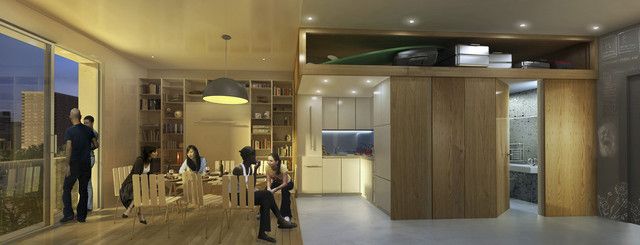Last-Minute NYC Holiday Gift Guide 🎁
We’ve created a holiday gift guide with presents for the intrepid New Yorker that should arrive just in time—


Rendering of micro-unit apartment. Source: Mayor’s Office
Next City’s Forefront Magazine took a deep dive into the problems of SRO (Single Room Occupancy) units in New York City, highlighting the story of an immigrant from Guinea living in a unit in Hunts Point, Bronx. His crowded, illegally converted building has blocked fire escapes and windows that don’t open. At $80/week, these type of housing situation is the only option for a portion of New York City’s population.
It’s estimated that 100,000 SROs exist across New York City. In describing the evolution of SRO’s Marina Ionava writes,
The story of single room occupancy is, in essence, a story about the complex relationship U.S. cities have with their poorest and most transient residents. SRO was born out of urban overcrowding as cities scrambled to meet housing demands produced by industrialization and the urban population explosion of the early 20th century. But over time, SRO evolved from a cramped but affordable housing option for the working class into a poorly regulated last resort for the most desperate populations.
In New York City, new construction of SRO housing was banned in 1955, motivated by a belief that these units led to substandard housing conditions. This, coupled with shifting ideologies which favored single-family homes, reduced the supply of this segment of affordable housing. Incentives were also given to encourage the conversion of SRO units. These factors have led to a gap in supply and demand, within which a substantial illegal sector has developed.
Mayor Bloomberg’s administration has been making moves to change the public perception of single room occupancy units. The exhibit Making Room: New Models for Housing New Yorkers at the Museum of the City of New York showcased five models for affordable, micro-units submitted by architects and developers in a 2012 challenge by the city called adAPT NYC.

A proposal from the adAPT NYC competition for a micro-dwelling tower (Photo: Alexander McQuilkin for Untapped Cities)
A modular proposal won the competition. The design contains 55 units sized between 250 and 370 square feet, with a number of communal amenities including performance space and a roof garden. It will be built using pre-fabricated modules assembled on the Brooklyn Navy Yard and has an expected delivery date of September 2015. The development was exempt from New York City’s zoning laws, which require 400 square feet on average per unit.
As Next City points out, however, these units will be much more expensive the current “market rate” of SROs. The new wave of micro-housing is targeted for millennials, not for the city’s urban poor. And as seen from the 311 complaint map released by the Fuhrman Center, illegal conversion of residential units continues to be a problem.
On a hopeful note, Next City writes, “Yet through the [adAPT NYC] initiative, Bloomberg has opened a door to a potential loosening of the regulations that prevent other kinds of small housing from being developed.”
Read more about New York City’s SRO issue at Next City’s Forefront Magazine. Read our previous interview with the designer of a 160 square foot micro-apartment in San Francisco.
Subscribe to our newsletter